You are using an out of date browser. It may not display this or other websites correctly.
You should upgrade or use an alternative browser.
You should upgrade or use an alternative browser.
Unveiling my brewery & garage build
- Thread starter fall-line
- Start date

Help Support Homebrew Talk:
This site may earn a commission from merchant affiliate
links, including eBay, Amazon, and others.
When I returned the grinder, I didn't say a word, but the guy behind the counter nodded to me and said, "every floor is it's own special brand of hell."
...
Great build, sir.
Thanks, Dgonza. I can definitely empathize with the special brand of hell statement. It was definitely one of the most unpleasant DIY projects I've ever tackled in 10+ years of home ownership.
After living with the less than ideal floor for a few weeks now, I'm satisfied enough with it to let it be until next spring. I did get a *very* reasonable quote from a pro that I have worked with before however to fix it, and I plan to hire him to do so. He's a great guy and we had a good time talking about the floor and the beer brewing operation when he was over. Since I've done all the hard work on it already, It will actually cost LESS (only a few bucks less, but still) for him to finish and seal the floor than it would for me to rent the machine and do it myself again. I'm looking forward to that, but am happy to just live with it in the mean time while I have so many other things to focus on.
NateLTB
Well-Known Member
What an awesome project! I wish I had my own garage to set up my brew-space; I'm totally envious.
If you ever decide to have any local homebrewers stop by and drool over your brewery (and trade some homebrew) let me know. I live in Longview but my girlfriend is in Woodinville so I'm up that way every other weekend.
Keep up the great work!
Cheers!
If you ever decide to have any local homebrewers stop by and drool over your brewery (and trade some homebrew) let me know. I live in Longview but my girlfriend is in Woodinville so I'm up that way every other weekend.
Keep up the great work!
Cheers!
Thanks, Nate. It'd be fun to have a few local brewers over for a collaborative brew day at some point in the future.
Well Damn.. my shiny new fridge that I bought for a steal on craigslist turns out to have a freon leak. I'm investigating doing a DIY recharge, but it looks like someone has already done that recently, indicating a serious leak. Even the newer 134a stuff is a killer on our ozone layer, so I'm leaning towards just scrapping it and starting over with the search for refrigerators.
It's a shame. It was working ok when I brought it home. I unplugged it for a few days and put a ton of work into it to convert it, and only then found the real problem.
It's a shame. It was working ok when I brought it home. I unplugged it for a few days and put a ton of work into it to convert it, and only then found the real problem.
A piece of advice for anyone looking to purchase a used fridge or freezer. Inspect the condensor coils (inside the freezer, usually behind a panel) closely. They should have a thin layer of frost on them. Mine did when I bought it, but no longer . Also take a close look at the back of the unit. Look at the compressor, and the copper lines that lead from it. If you see any sort of a 'tap', installed these lines, you know someone has recharged the refrigerant, and you almost certainly have a leak. (see photo below)
Yes you can re-charge it again yourself, but it's terrible for the ozone layer. If you have a refrigerant leak, you should really consider scrapping the fridge.
The silver 'tap' hanging off the copper pigtail is a bad sign.. if you see this on a fridge you are buying, don't!
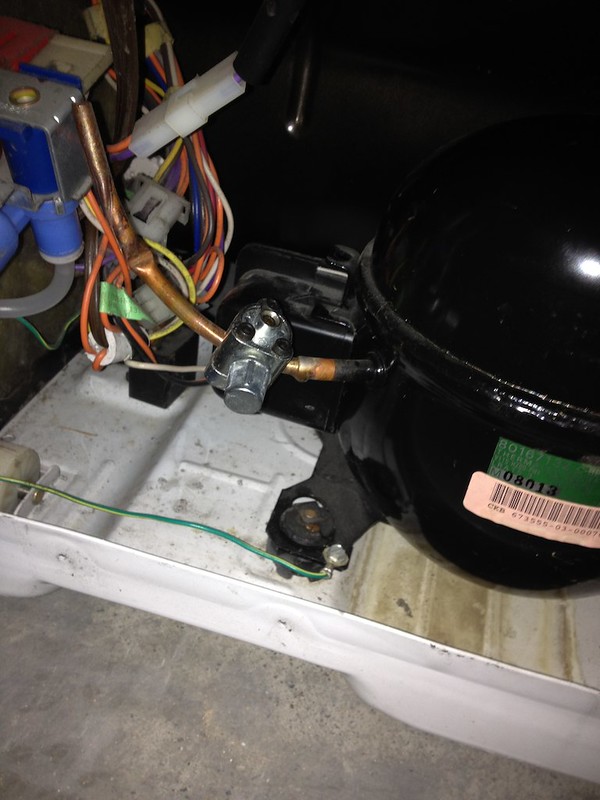
If your refrigerant is low, your evaporator coils will only have a little bit of frost at the beginning, they should have frost all the way through.
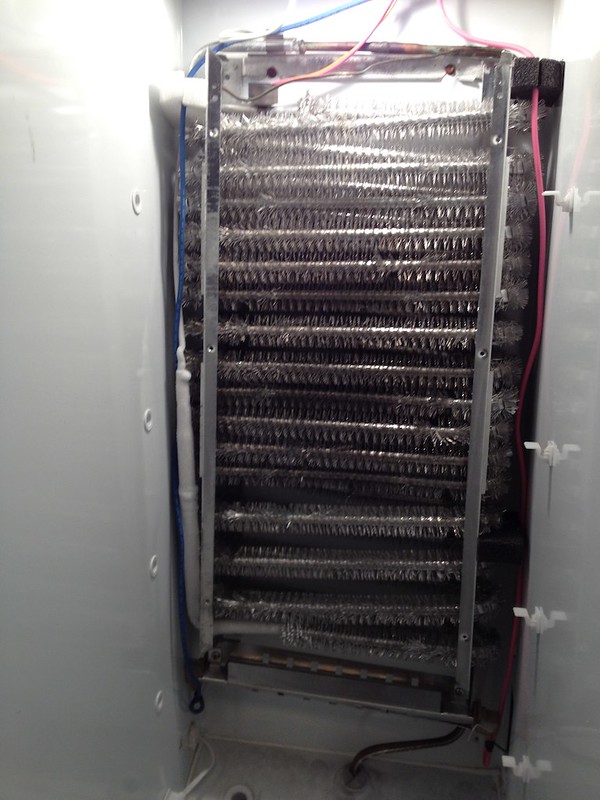
Yes you can re-charge it again yourself, but it's terrible for the ozone layer. If you have a refrigerant leak, you should really consider scrapping the fridge.
The silver 'tap' hanging off the copper pigtail is a bad sign.. if you see this on a fridge you are buying, don't!

If your refrigerant is low, your evaporator coils will only have a little bit of frost at the beginning, they should have frost all the way through.


$176.97
1pc Commercial Keg Manifold 2" Tri Clamp,Ball Lock Tapping Head,Pressure Gauge/Adjustable PRV for Kegging,Fermentation Control
hanhanbaihuoxiaoshoudian

$20.94
$29.99
The Brew Your Own Big Book of Clone Recipes: Featuring 300 Homebrew Recipes from Your Favorite Breweries
Amazon.com

$10.99 ($31.16 / Ounce)
Hornindal Kveik Yeast for Homebrewing - Mead, Cider, Wine, Beer - 10g Packet - Saccharomyces Cerevisiae - Sold by Shadowhive.com
Shadowhive

$33.99 ($17.00 / Count)
$41.99 ($21.00 / Count)
2 Pack 1 Gallon Large Fermentation Jars with 3 Airlocks and 2 SCREW Lids(100% Airtight Heavy Duty Lid w Silicone) - Wide Mouth Glass Jars w Scale Mark - Pickle Jars for Sauerkraut, Sourdough Starter
Qianfenie Direct

$22.00 ($623.23 / Ounce)
AMZLMPKNTW Ball Lock Sample Faucet 30cm Reinforced Silicone Hose Secondary Fermentation Homebrew Kegging joyful
无为中南商贸有限公司

$7.79 ($7.79 / Count)
Craft A Brew - LalBrew Voss™ - Kveik Ale Yeast - For Craft Lagers - Ingredients for Home Brewing - Beer Making Supplies - (1 Pack)
Craft a Brew

$53.24
1pc Hose Barb/MFL 1.5" Tri Clamp to Ball Lock Post Liquid Gas Homebrew Kegging Fermentation Parts Brewer Hardware SUS304(Liquid Hose Barb)
Guangshui Weilu You Trading Co., Ltd

$53.24
1pc Hose Barb/MFL 1.5" Tri Clamp to Ball Lock Post Liquid Gas Homebrew Kegging Fermentation Parts Brewer Hardware SUS304(Liquid Hose Barb)
yunchengshiyanhuqucuichendianzishangwuyouxiangongsi

$479.00
$559.00
EdgeStar KC1000SS Craft Brew Kegerator for 1/6 Barrel and Cornelius Kegs
Amazon.com

$58.16
HUIZHUGS Brewing Equipment Keg Ball Lock Faucet 30cm Reinforced Silicone Hose Secondary Fermentation Homebrew Kegging Brewing Equipment
xiangshuizhenzhanglingfengshop
Jaysus
Well-Known Member
Looks awesome!
P.S. Where's the urinal?
P.S. Where's the urinal?
There is plumbing for a urinal right next to the POS fridge. Right now though, I just feel like turning the fridge into a urinal!
There is plumbing for a urinal right next to the POS fridge. Right now though, I just feel like turning the fridge into a urinal!
Have you seen the beer keg urinal's? That would be perfect for your place.
Sorry to hear about the fridge.
Awesome job fall-line! Great design and implementation on it. One question though - have you parked a car in this garage yet? 
Have you seen the beer keg urinal's? That would be perfect for your place.
Sorry to hear about the fridge.
Yeah, there is a local brew pub here that has an awesome one. It's one of those projects I look forward to tackling in the distant future on some long winter weekend when I have nothing better to do than screw around in the shop.
Awesome job fall-line! Great design and implementation on it. One question though - have you parked a car in this garage yet?
Believe it or not, I have! I've put my car in there a few nights, and brought my wife's car in when I was working on her lights.
I'm not really able to drive a car into it right now though.. I had to build a gravel curb at the edge of the alleyway to keep water runoff from entering the door during our last big rain. Until I get that paved, it is off limits to car traffic.
Well Damn.. my shiny new fridge that I bought for a steal on craigslist turns out to have a freon leak. I'm investigating doing a DIY recharge, but it looks like someone has already done that recently, indicating a serious leak. Even the newer 134a stuff is a killer on our ozone layer, so I'm leaning towards just scrapping it and starting over with the search for refrigerators.
It's a shame. It was working ok when I brought it home. I unplugged it for a few days and put a ton of work into it to convert it, and only then found the real problem.
I did a little (ok, a LOT) more research on this subject, and in the end curiosity got the better of me. I realized that either way, I'm going to be polluting, it's just a matter of the air or the land(fill). I discovered that 134a refrigerant used by fridges, your car's A/C, etc has a Global Warming Potential score of 3400, when it is released into the atmosphere (it breaks down over time, but this is the worst case scenario. Carbon dioxide's score is 1, for reference.
This means that 1 oz of 134a = 3400 oz of co2 in terms of "relative impact" on the atmosphere, according to the best scale we have fore measuring such things. 3400 / 16 (oz to a lb) = 212.5lb. There are approximately 20lbs of co2 released for every gallon of gas that you burn, so that means releasing 1oz of 134a into the atmosphere is approximately as bad as driving your car long enough to burn 11 gallons of gas..
My fridge takes 4oz of 134a, so even if I fill it all the way up and it all leaks out, it's only a couple of tanks of gas worth of atmospheric impact.. according to the references above, and the shaky math.. The impact is definitely there, but it's not the massive guilt inducing amount I had feared.
Armed with that knowledge I trudged off to the auto parts store to get a few items: A can of 134a, an a/c recharge pressure gauge, and an adapter to connect the snap on socket to my tap's threaded socket (note, my fridge already had one of these installed)
I watched a youtube video, and got to work.
Recharging the refrigerant
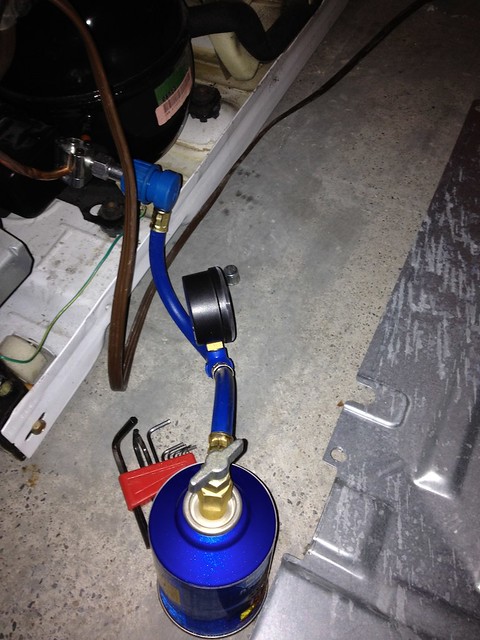
Almost instantly I could hear the compressor start to work harder. I went around front and looked inside the freezer and I could see frost forming on the remaining coils before my eyes. I didn't do the recharge very scientifically. I just added a little bit, then waited a few minutes and looked at the frost pattern, then repeated until the frost got almost to the top of the coils (not all the way as I didn't want to overfill.) I should have used my kitchen scale (the same I use to measure hops) to meeter out ~4oz, to be more precise.
After about 30 minutes of filling, waiting, and watching, the coils had a nice layer of frost, and the temp in the freezer had fallen from 40ºF (ambient temp in the garage was 51ºF for comparison) to -2ºF!
The coils, after recharging. Compare to the picture on the previous page.
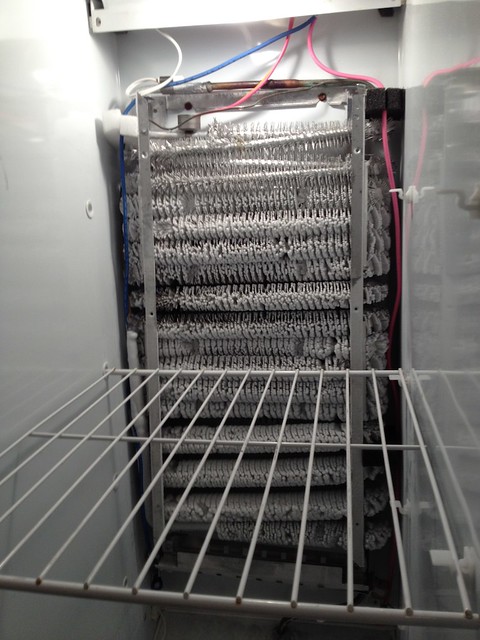
Now, there is no guarantee that this will last. The refrigerant may leak out over the next few weeks and I'll be back to square one, having polluted the atmosphere. I talked to the guy I bought the fridge from however and he said he had no knowledge of it being recharged in the past. The last service record I could find for it was from 2003.. so there is a chance that the leak is so slow that this will last, and keep this massive thing out of the landfill for years to come.
I'll keep you posted. I'm keeping my fingers crossed!
NOTE: 134a, despite the justification I wrote above is still nasty stuff. Please be very careful with it for your own health, an the health of our environment.
Last edited by a moderator:
Thomsen1287
Active Member
- Joined
- May 8, 2012
- Messages
- 26
- Reaction score
- 2
I can empathize on finishing the concrete, I've been involved with an ongoing project to refinish 25,000 sq ft of 20 year old concrete, from 30 grit all the way to 3500 all dry. We are doing it all dry with a giant shop vac that runs on 240, and using a floor scrubber between grits
25,000sq feet.. wow, I can't even imagine. That'd take weeks at the rate I was going.
Thomsen1287
Active Member
- Joined
- May 8, 2012
- Messages
- 26
- Reaction score
- 2
We did a test run on about 1000 sq ft from start to finish, took us 16 hours but we learned a lot. We're moving a bit faster than that now but the equipment only goes so fast
Now that my fridge is tentatively working (so far, it is holding temperatures great with very little compressor activity), I can show you the rest of the conversion process, that started back in post #206.
I decided to try and install my tap board without any visible mounting hardware, so I got a length of threaded 8-32 rod, and some threaded insert nuts that I screwed and epoxied into the back of my board.
Here is the threaded rod secured in the insert nut, from the back of the board

It's bolted to the door with 4 sets of these rod/insert nut combinations, using a small piece of painted plywood for the backer. I've insulated thoroughly between the pieces of wood.
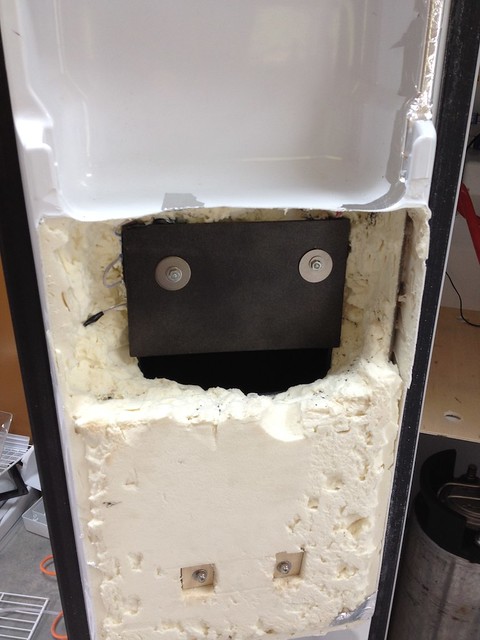
Front the front, fully mounted and ready for the shanks
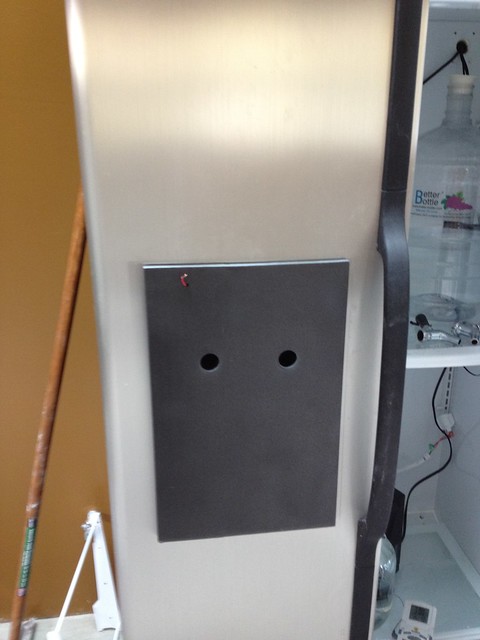
Now with shanks and drip tray installed
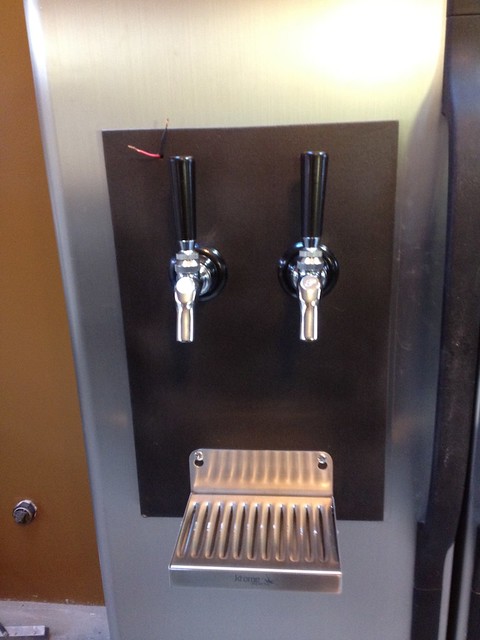
And the final product. I really like how it came out. I hope the fridge lasts!

I decided to try and install my tap board without any visible mounting hardware, so I got a length of threaded 8-32 rod, and some threaded insert nuts that I screwed and epoxied into the back of my board.
Here is the threaded rod secured in the insert nut, from the back of the board

It's bolted to the door with 4 sets of these rod/insert nut combinations, using a small piece of painted plywood for the backer. I've insulated thoroughly between the pieces of wood.

Front the front, fully mounted and ready for the shanks

Now with shanks and drip tray installed

And the final product. I really like how it came out. I hope the fridge lasts!

Progress..slow progress.. on the outside of the building. The new rain tanks have arrived. The space they are going is exactly 1/2" wider than the tanks, so I'm going to have to wrestle them in place and then go into my neighbors yard to reach through the fence plumb then up. Once we get a few days of dry weather, I'll get on it.
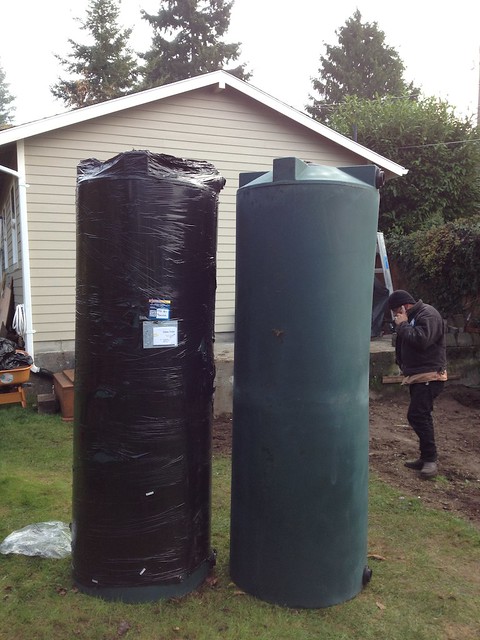
Meanwhile the deck construction is about to begin. That guy in the picture above is my contractor, calling in an order for materials for the deck, which will cover up the mud pit he is standing in. He and I will be working on the deck build together, though I'm getting to the point in this whole project where I'm ready to step back and let him just get it done.

Meanwhile the deck construction is about to begin. That guy in the picture above is my contractor, calling in an order for materials for the deck, which will cover up the mud pit he is standing in. He and I will be working on the deck build together, though I'm getting to the point in this whole project where I'm ready to step back and let him just get it done.
RhoadsRunner
Member
Sub....wait for it...scribe-ing to this thread. Can't wait to see the whole thing!
BadNewsBrewery
Well-Known Member
www.superbrightleds.com makes some quality LEDs you could use for the light strip on your tap. Amazing build! You have inspired (and crushed) every man to read this. We are all jealous of your progress and the potential, and understanding of your pain and sorrow.
-Kevin
-Kevin
...
After about 30 minutes of filling, waiting, and watching, the coils had a nice layer of frost, and the temp in the freezer had fallen from 40ºF (ambient temp in the garage was 51ºF for comparison) to -2ºF!
The coils, after recharging. Compare to the picture on the previous page.

Now, there is no guarantee that this will last. The refrigerant may leak out over the next few weeks and I'll be back to square one, having polluted the atmosphere. I talked to the guy I bought the fridge from however and he said he had no knowledge of it being recharged in the past. The last service record I could find for it was from 2003.. so there is a chance that the leak is so slow that this will last, and keep this massive thing out of the landfill for years to come.
I'll keep you posted. I'm keeping my fingers crossed!
A small update here, it's been 2 weeks and so far there has been no perceptible change in the cooling capability of the freezer. I'll give it a couple more weeks to empty the kegs in there, then I'll pull off the back panel and do another frost pattern exam, but it looks like it'll hold up for a while. Problem solved? Perhaps, more like problem successfully mitigated..
I've been slowing down, both in terms of getting work accomplished and taking pictures to document it. The last major effort in this project is now underway though, as the deck is starting to take shape

Meanwhile I've been occupying myself with beer and cider making, and thoroughly enjoying the garage. The brew stand is working great, though a few changes will be coming in the next few months, mainly automation related.

Meanwhile I've been occupying myself with beer and cider making, and thoroughly enjoying the garage. The brew stand is working great, though a few changes will be coming in the next few months, mainly automation related.
schwibbidy
Well-Known Member
- Joined
- Apr 12, 2012
- Messages
- 53
- Reaction score
- 1
Where do you live? I'm in colorado and am looking for ideas in my backyard, I was wondering what area and what soils you have to deal with for your concrete foundations
I'm in Western Washington, schwibbidy. Sadly I don't think my experiences with my soil here will be of much help to you. When in doubt, bring in an engineer with experience in your area.
Best of luck with your build.
Best of luck with your build.
No snow at my place, though there is snow all around the city this morning. I live about 1/4 mile from the water, so it has to be really cold to snow here.
Even so, all we have going on is the deck build and some landscaping, so no damage can be done from the snow. Thanks for asking though!
Even so, all we have going on is the deck build and some landscaping, so no damage can be done from the snow. Thanks for asking though!
Similar threads
- Replies
- 3
- Views
- 979
- Replies
- 6
- Views
- 917
- Replies
- 1
- Views
- 889












































![Craft A Brew - Safale BE-256 Yeast - Fermentis - Belgian Ale Dry Yeast - For Belgian & Strong Ales - Ingredients for Home Brewing - Beer Making Supplies - [3 Pack]](https://m.media-amazon.com/images/I/51bcKEwQmWL._SL500_.jpg)


